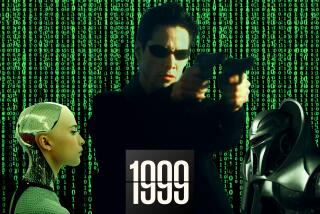Director makes sure his story gets ‘Under the Skin’

Actress Scarlett Johansson topped the box office charts last weekend playing the character of Black Widow in the Marvel superhero flick “Captain America: The Winter Soldier.” That same weekend she was on screen as a man-eater of a different type in the cryptic indie sci-fi film “Under the Skin.”
As a space alien in human form who lures male victims into a mysterious black void, Johansson gives a performance at once sinister, sultry and unexpectedly sympathetic. If “Captain America” was the latest product of a studio franchise machine, “Under the Skin” was the handcrafted result of writer-director Jonathan Glazer’s 10-year quest to bring a singular experience to the screen.
Based on the novel by Michel Faber — “a jumping-off point,” said Glazer — the story evolved and grew only to be stripped to its sparest essentials. The film is in its own way both unforgiving and enveloping, lacking in conventional exposition though everything becomes clear enough as the alien predator goes about her work.
CRITICS’ PICKS: What to watch, where to go, what to eat
Glazer captured at least some of the story’s action by sending Johansson, with dark hair, tight jeans and a stalker’s blank stare, out into the streets of Glasgow, Scotland. Having overseen development of a bespoke camera system to capture the action covertly, Glazer had a van outfitted with eight cameras for Johansson to troll the city with, enticing strangers to hop in to meet their narrative doom. In a shopping mall or nightclub she is surrounded by unwitting extras, and when she trips and falls on a city street, the people who help her up are real.
For a film that took so long to bring to the screen and plays out as so tightly, minutely calibrated, to ultimately leave so much to the chance of the day seems risky.
“It wasn’t like I was working without a script,” Glazer said recently over an early morning tea in Los Angeles. “I was working very clearly within the margins of the script we had written.
“I wanted to shoot a film that was rooted in the real world. The story was about an alien in the real world. And then you work out a way to really achieve the sensation that you were someone who wasn’t of this world. That’s the methodology being the equivalent of the narrative. And it can take a long time to get to that simplicity.”
Having made his name as a director of commercials and music videos, the London-born Glazer, now 49, made his feature debut in 2000 with the widely hailed gangster picture “Sexy Beast” that gave audiences a whole new appreciation for Ben Kingsley. His 2004 film “Birth” with Nicole Kidman received a more mixed response, though its critical standing has risen in the ensuing years. When “Under the Skin” finally premiered on the festival circuit last fall, it also met with sharply diverging responses.
PHOTOS: Stars who turned down, or were turned down for, ultimately famous roles
“I think what’s really important for a filmmaker is to understand that whether something is good and whether it’s well received are two completely unconnected things,” said Glazer. “As long as I feel what I’ve done is what I set out to do, as close as I could get to, if it’s badly received, I’m fine with that, it’s not a problem.”
When “Under the Skin” recently opened in the U.K., at least two major reviewers reversed their initial negative opinions from when they first saw the film on the festival circuit. Another declared she “hated, hated, hated” every minute of it. Already playing in Los Angeles and expanding around the country, the film opened last weekend in the U.S. as the second-best limited release of the year, with a per screen average of $35,000.
“You’d have to be nuts to have made that film and think that it’s going to be everyone’s cup of tea,” said producer James Wilson, who also worked with Glazer on “Sexy Beast” and “Birth” and who first sent him the novel. “Everyone knew it was a film that might polarize people.”
It has been oft-noted that in the recent Spike Jonze film “Her” Johansson was heard as a computer-generated consciousness, a voice without a body, and in “Under the Skin” she is largely a body without a voice. Johansson said that while she now sees the way in which both characters are experiencing the world for the first time, any similarities have come to her only as she has been asked about it on the “Under the Skin” press tour.
“She has no ill will,” said Johansson of her character in “Under the Skin.” “This isn’t a film about woman preying on man or a kind of hypersexual relationship. It has nothing to do with those things, it’s merely a lioness on the prowl, hunting. I think by the end of the film if you as the audience can feel sympathy for this other species as she begins to sympathize with us, that’s the experience.”
BEST MOVIES OF 2013: Turan | Sharkey | Olsen
With its custom cameras and subtly hidden digital effects, the visual sleight-of-hand in the film functions at such a high level that it can often be difficult for a viewer to understand exactly what he is seeing. Within the context of the sly sci-fi of the film, and what Glazer calls a “chaotic, beautiful ugliness,” a human body is drained from the inside to leave only a flapping skin-bag, a solid floor becomes a dark, enveloping ooze, an international superstar strips completely naked and a disfigured man is shown a kindness.
The film’s air of uncertainty and mystery seems to envelop even Johansson and Glazer as they contradict each other as to how the terrifying transformation of the film’s climax was achieved. Johansson mentions wearing a prosthetic suit of herself — something Glazer doesn’t recall.
“Do not ask me how any of that happened at all,” she said. “All I know is that when we were doing it I kept thinking, ‘I hope this doesn’t look like a weird monster movie.’ But you just can’t doubt Jonathan’s visual vocabulary.”
Glazer’s exploratory process spilled over into other aspects of the production as well. For the score he enlisted the classically trained avant-pop musician Mica Levi, who had never before composed music for a film. In a collaborative 10-month process Levi would compose and record music with a small ensemble and Glazer would sometimes reshape sequences to go with what she was doing.
“It was like, ‘Does the film need this?’” said Levi. “He’d talk about the film as if it wasn’t to do with him. He was working on it, and it was figuring itself out.”
“Under the Skin” may be the season’s conversation-starter picture, with its complicated, at times conflicting, moods of dread and desire, vulnerability and danger as Johansson’s alien becomes just a little human. Glazer spent more than a decade chasing after an indescribable something that in the end he thinks he captured.
“It’s a feeling more than anything else,” Glazer said. “Looking back now, I think it doesn’t represent how I thought it would look and be, but it feels as I expected it to. And the feeling is your North Star, it’s the thing you have that takes you through it.”
And that feeling, what is it?
“Well, that’s the film,” Glazer said. “I can’t distill it down into an answer other than the film.”
More to Read
Only good movies
Get the Indie Focus newsletter, Mark Olsen's weekly guide to the world of cinema.
You may occasionally receive promotional content from the Los Angeles Times.







